- Home
- Walter Isaacson
A Benjamin Franklin Reader
A Benjamin Franklin Reader Read online
Also by Walter Isaacson
Benjamin Franklin: An American Life
Kissinger: A Biography
The Wise Men: Six Friends and the World They Made (with Evan Thomas)
Pro and Con
SIMON & SCHUSTER PAPERBACKS
Rockefeller Center
1230 Avenue of the Americas
New York, NY 10020
Copyright © 2003 by Walter Isaacson
All rights reserved,
including the right of reproduction
in whole or in part in any form.
First Simon & Schuster paperback edition 2005
SIMON & SCHUSTER PAPERBACKS and colophon are registered trademarks of Simon & Schuster, Inc.
Designed by Jaime Putorti
The Library of Congress has cataloged the hardcover edition as follows: Franklin, Benjamin, 1706–1790.
[Selections. 2003]
A Benjamin Franklin reader / edited and annotated by Walter Isaacson.
p. cm.
“Including: THE AUTOBIOGRAPHY, Poor Richard’s Almanac, Silence Dogood’s letters, Polly Baker’s trial, bagatelles to his French girlfriends, the closing speech at the Constitutional Convention, letters to Jefferson and Adams and Washington, and many other wonderful writings from America’s favorite Founder.”
1. Franklin, Benjamin, 1706–1790—Archives. 2. United States—Politics and government—To 1775—Sources. 3. United States—Politics and government—1775–1783—Sources. 4. Franklin, Benjamin, 1706–1790. 5. Statesmen—United States—Biography. 6. Scientists—United States—Biography. 7. Printers—United States—Biography. I. Isaacson, Walter. II. Title.
E302.F82 2003
973.3’092—dc22 2003055788
ISBN 13: 978-0-7432-7483-8
ISBN 10: 0-7432-7483-0
Visit us on the World Wide Web:
http://www.SimonSays.com
Contents
Chronology
Key Characters
Introduction
Part 1: The Young Apprentice
Silence Dogood Introduces Herself
Silence Dogood on Courtship
Silence Dogood Attacks Harvard
Silence Dogood’s Recipe for Poetry
Silence Dogood Attacks the Puritan Theocracy
Silence Dogood Proposes Civic Improvements
A Dissertation on Liberty and Necessity
Plan of Conduct
Advice to His Sister on Her Marriage
A New Creed and Liturgy
Part 2: The Philadelphia Printer
The First Abortion Controversy
The Busy-Body
Franklin the Editor
The Lessons of Misprints
Rules for Marriage
A Scolding Wife
A Witch Trial at Mount Holly
A Printer’s Creed
Sex Sells
Anthony Afterwit on Marriage
Celia Single Responds
In Praise of Gossip
The Discussion Club
How to Please in Conversation
Part 3: Poor Richard and Friends
Introducing Poor Richard
Poor Richard vs. Mr. Leeds
On the Death of Infants
Poor Richard Denies He Is Franklin
Faith Versus Good Works
Poor Richard Blames His Printer
The Drinker’s Dictionary
How to Write an Almanac
Poor Richard’s Wife Takes Her Turn
Poor Richard Defends Astrology and Wit
A Defense of Religious Tolerance
A Ballad for Deborah
Reasons to Choose an Older Mistress
Polly Baker’s Trial
Part 4: The Public Citizen
A Call to Arms for the Middling People
The University of Pennsylvania
How to Be a Good Tradesman
Rattlesnakes for Felons
Magical Squares
On Welfare Dependency
The Albany Plan for an American Union
Catherine Ray
A Parable on Intolerance
The Way to Wealth: The Sayings of Poor Richard
Part 5: Lobbyist in London
Reasons for Restoring Canada to France
Mary Stevenson
David Hume
On Observing the Sabbath
When Oil Does Not Calm Troubled Waters
Race and Slavery
Propaganda Agent
A Paean to Deborah
The Grumpy Boarder
More on Welfare Dependency
Cold Air Baths
The Fable of the Lion and the Dog
Polly Gets Married
The Cravenstreet Gazette
A Showdown with Lord Hillsborough
The Seeds of a Total Disunion
How to Weigh a Decision
Ode to a Squirrel
The Cause of Colds
Parody Rules and an Edict Directed at Britain
Part 6: American Rebel
You Are My Enemy
Proposed Articles of Confederation
The Rattlesnake as America’s Symbol
Part 7: Ambassador in Paris
An Appeal to France’s Interests
The Sale of the Hessians
A Form Letter of Recommendation
The Twelve Commandments, to Madame Brillon
A Proposed Treaty with Madame Brillon
Bagatelle of the Ephemera
Madame Helvétius and Elysian Fields
John Paul Jones
To His Daughter on Fame, Frugality, and Grandchildren
The Morals of Chess
Bagatelle on St. Peter’s Tolerance
On Wine and the Elbow
To George Washington on Reputation
John Adams
Dialogue Between the Gout and Mr. Franklin
The Science of Farts
A Fable About Misguided Loyalists
Seducing the French
To Polly on Her Mother and the Futility of War
A Critique of Excess Wealth
On Hereditary Honors and the Turkey
A Vision of America
No Longer His Enemy
Daylight Savings Time
The Prodigal William
On Wishes, Age, and Bifocals
Part 8: Constitutional Sage
The Constitutional Convention
Motion for Prayers
Franklin’s Closing Speech
A Miffy Family
Webster’s Dictionary
On the Abolition of Slavery
The Final Parody, on Slavery
On Jesus Christ
To Thomas Jefferson
Last Will and Codicil
Part 9: The Autobiography
The Autobiography
Chronology
1706 Born in Boston on January 17 (Jan. 6, 1705, Old Style).
1714 Attends Boston Latin.
1718 Apprenticed to brother James.
1722 Writes Silence Dogood essays.
1723 Runs away to Philadelphia.
1724 Moves to London.
1725 “A Dissertation on Liberty and Necessity, Pleasure and Pain.”
1726 Returns to Philadelphia.
1728 Opens his own print shop.
1729 Writes Busy-Body essays. Buys Pennsylvania Gazette.
1730 Enters common-law marriage with Deborah Read. William born.
1731 Founds library.
1732 Francis born. Launches Poor Richard’s Almanac.
1733 Moral perfection project.
1735 Controversy over preacher Samuel Hemphill.
1736 Clerk of Pa. Assembly. Francis dies. Forms Union Fire Co.
1737 Made Philadelphia postmaster.
1741 Launches General Magazine, which fails. Designs stove.
1743 Sarah (“Sally”) born. Launches American Philosophical Soc.
1745 Collinson sends electricity pamphlets and glass tube.
1746 Summer of electricity experiments.
1747 Writes “Plain Truth.” Organizes militia.
1748 Retires from printing business.
1749 Writes proposal for the Academy (Univ. of Penn.).
1751 Electricity writings published in London. Elected to Pa. Assembly.
1752 Kite and lightning experiment.
1753 Becomes joint postmaster for America.
1754 French and Indian War begins. Albany plan of union.
1757 Leaves for London as agent. Writes “Way to Wealth” and last Poor Richard’s Almanac. Moves in with Mrs. Stevenson on Craven Street.
1758 Visits Ecton to research ancestry with William.
1761 Travels to Flanders and Holland with William.
1762 Returns to Philadelphia. William made royal governor of N.J., marries.
1763 Postal inspection trip from Virginia to New England. French and Indian War ends.
1764 Paxton Boys crisis. Defeated in bitter Assembly election. Returns to London as agent.
1765 Stamp Act passes.
1766 Testifies in Parliament against Stamp Act, which is repealed.
1767 Townshend duties imposed. Travels to France.
1768 Wages press crusade in London on behalf of the colonies.
1769 Second visit to France.
1770 Townshend duties repealed except on tea. Made agent for Massachusetts.
1771 Begins Autobiography. Visits Ireland and Scotland.
1773 Writes parodies “Rules by Which a Great Empire May Be Reduced to a Smaller One” and “Edict of the King of Prussia.” Boston Tea Party.
1775 Returns to Philadelphia. Battles of Lexington and Concord. Elected to Second Continental Congress. Proposes first Articles of Confederation.
1776 William removed as royal governor, imprisoned in Connecticut. Declaration of Independence. Goes to France with Temple and Benny.
1777 Settles in Passy, feted throughout Paris.
1778 Treaties of alliance and commerce with France.
1779 Salons of Madames Brillon and Helvétius. John Paul Jones’s Bonhomme Richard defeats the Serapis.
1781 Appointed (with Adams and others) to negotiate, in Paris, peace with Britain.
1785 Last meeting with William. Returns to Philadelphia.
1787 Constitutional Convention. Elected president of Pa. Society for Promoting the Abolition of Slavery.
1790 Dies on April 17 at age 84.
Key Characters
JOHN ADAMS (1735–1826). Massachusetts patriot, second U.S. president. Worked with Franklin editing Jefferson’s draft of the Declaration of Independence in 1776. Arrived in Paris April 1778 to work with Franklin as commissioner.
BENJAMIN “BENNY” FRANKLIN BACHE (1769–1798). Son of Sally and Richard Bache, traveled to Paris with grandfather Franklin and cousin Temple in 1776.
RICHARD BACHE (1737–1811). Struggling merchant who married Franklin’s daughter Sally in 1767. They had seven children who survived infancy: Benjamin, William, Louis, Elizabeth, Deborah, Sarah, and Richard.
ANDREW BRADFORD (1686–1742). Philadelphia printer and publisher of the American Weekly Mercury, he became a competitor of Franklin’s and supported the Proprietary elite.
ANNE-LOUISE BOIVIN D’HARDANCOURT BRILLON DE JOUY (1744–1824). Franklin’s neighbor in Passy, Madame Brillon was an accomplished harpsichordist who became one of Franklin’s favorite female friends. Wrote Marche des Insurgents to commemorate American victory at Saratoga.
PETER COLLINSON (1694–1768). London merchant and scientist who helped Franklin set up the library and furnished him with electricity tracts and equipment.
FRANCIS DASHWOOD, BARON LE DESPENCER (1708–1781). British politician postmaster who protected and then had to fire his friend Franklin as the deputy postmaster for America. At his country house, Franklin had the pleasure of hearing his hoax “An Edict from the King of Prussia” fool people.
ABIAH FOLGER FRANKLIN (1667–1752), Born on Nantucket, she married Josiah Franklin in 1689 and had ten children, including Benjamin.
DEBORAH READ FRANKLIN (1705?–1774). Franklin’s loyal, common-law wife, she was raised on Market Street in Philadelphia and never left that neighborhood for the rest of her life. She first saw Franklin in October 1723 when he straggled off the boat into Philadelphia. She married John Rogers, who abandoned her. Entered common-law union with Franklin in 1730. Two children: Francis “Franky” who died at age 4 and Sarah “Sally.”
JAMES FRANKLIN (1697–1735). Franklin’s brother and early master, he started the New-England Courant in 1721 and was a pioneer in provocative American journalism.
JANE FRANKLIN [MECOM] (1712–1794). Franklin’s youngest sister and favorite sibling.
JOSIAH FRANKLIN (1657–1745). A silk dyer born in Ecton, England, he was the youngest son of a large family and migrated to America in 1683, where he became a candlemaker. Had seven children by his first wife Anne Child and ten (including Benjamin) by his second wife Abiah Folger Franklin.
SARAH “SALLY” FRANKLIN [BACHE] (1743–1808). Loyal only daughter, married Richard Bache in 1767. Served as hostess and homemaker when Franklin returned to Philadelphia in 1776 and then 1785.
[WILLIAM] TEMPLE FRANKLIN (c. 1760–1823). Illegitimate son of William Franklin. Grandfather helped to raise and educate him, brought him back to America in 1775, took him to Paris in 1776, retained his loyalty in struggle with the boy’s father. Had his own illegitimate children. Published a haphazard collection of his grandfather’s writings.
WILLIAM FRANKLIN (c. 1730–1813). Illegitimate son raised by Franklin. Accompanied him to England, became a Tory sympathizer, appointed royal governor of New Jersey, remained loyal to the crown and split with his father.
ANNE-CATHERINE DE LIGNIVILLE HELVÉTIUS (1719–1800). Franklin’s close friend in France. Widowed in 1771 from wealthy philosopher Claude-Adrien Helvétius. Franklin proposed marriage, more than half-seriously, in 1780.
LORD HILLSBOROUGH (1718–1793). Wills Hill, the first Marquis of Downshire and the Viscount of Hillsborough, Britain’s colonial secretary from 1768–72 and Franklin’s antagonist.
DAVID HUME (1711–1776). Scottish historian and philosopher, he was (with Locke and Berkeley) one of the greatest British empirical analysts. Franklin befriended him in London and visited him in Edinburgh in 1759 and 1771.
SAMUEL KEIMER (c. 1688–1742). A London printer, he moved to Philadelphia in 1722 and gave Franklin his first job there the following year. Franklin had a stormy relationship with him, became his competitor, and Keimer left for Barbados in 1730.
COTTON MATHER (1663–1728). Prominent Puritan clergyman and famed witch-hunter who succeeded his father Increase Mather as pastor of Boston’s Old North Church. His writings inspired Franklin’s civic projects.
THOMAS PENN (1702–1775). Son of William Penn, he became, in 1746, the primary Proprietor of Pennsylvania, based in London with his brother Richard. He was one of Franklin’s foremost political enemies.
JOSEPH PRIESTLEY (1733–1804). Theologian who turned to science. Met Franklin in 1765. Wrote a history of electricity (1767) that stressed Franklin’s work. Isolated oxygen and other gases.
SIR JOHN PRINGLE (1707–1782). Physician who became Franklin’s close English friend and traveling companion.
CATHERINE RAY [GREENE] (1731–1794). Met Franklin on his 1754 trip to New England and became his first major young female flirtation. Married in 1758 William Greene, who became governor of Rhode Island, but remained a friend of Franklin. (She signed her name “Caty,” but Franklin tended to address her as “Katy” or “Katie.”)
JONATHAN SHIPLEY, BISHOP OF ST. ASAPH (1714–1788). Anglican bishop at whose house Twyford, near Winchester, Franklin began his autobi
ography.
MARGARET STEVENSON (1706–1783). Franklin’s landlady on Craven Street, off the Strand, and occasional companion in London.
MARY “POLLY” STEVENSON [HEWSON] (1739–1795). Mrs. Stevenson’s daughter, longtime flirtatious young friend and intellectual companion to Franklin. Married in 1770 to medical researcher William Hewson. Widowed in 1774, visited Franklin in Paris in 1785, moved to Philadelphia in 1786 to be at his deathbed.
WILLIAM STRAHAN (1715–1785). London printer who became Franklin’s close friend via letters before even meeting him in person. Franklin wrote but did not send a famous “you are my enemy” letter to him during the Revolution, but they actually remained friends.
BENJAMIN VAUGHAN (1751–1835). Franklin’s close friend in London, he compiled many of Franklin’s papers and helped to negotiate with him the final peace treaties with Britain.
CHARLES GRAVIER, COMTE DE VERGENNES (1717–1787). French foreign minister, 1774–1787, with whom Franklin negotiated an alliance.
Introduction
When he was a young teenager working as an apprentice at his brother’s printing shop in Boston, Benjamin Franklin, America’s original apostle of self improvement, devised a wonderful little method to teach himself how to be a powerful and persuasive writer. He would read the essays of Joseph Addison and Richard Steele in The Spectator, the irreverent London daily that flourished in 1711–12, take notes, jumble them up, set them aside, and then return to them a few days later to see how well he could replicate the original. Sometimes he would even turn the notes into poetry, which helped him expand his vocabulary by forcing him to search for words with the right rhythm or rhyme, before trying to recreate what Addison and Steele had written.
When he found his own version wanting, he would correct it. “But I sometimes had the pleasure,” he recalled, “of fancying that in certain particulars of small import I had been lucky enough to improve the method or the language, and this encouraged me to think that I might possibly in time come to be a tolerable English writer, of which I was extremely ambitious.”
More than making himself merely “tolerable,” he became the most popular writer in colonial America. He may also have been, as the great literary historian Carl Van Doren has flatly declared, “the best writer in America” during his lifetime. (The closest rival for that title would probably be the preacher Jonathan Edwards, author of such vivid sermons as “Sinners in the Hands of an Angry God,” who was certainly more intense and literary, though far less felicitous and amusing.) Franklin’s self-taught style, as befitting a protégé of Addison and Steele, featured a direct and conversational prose, which was lacking in poetic flourish but was powerful in its directness and humor.

 Benjamin Franklin: An American Life
Benjamin Franklin: An American Life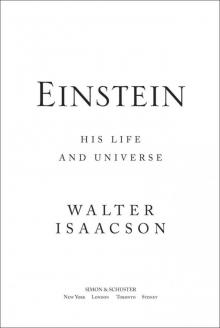 Einstein: His Life and Universe
Einstein: His Life and Universe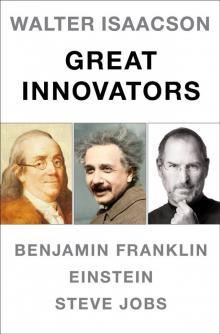 Walter Isaacson Great Innovators e-book boxed set
Walter Isaacson Great Innovators e-book boxed set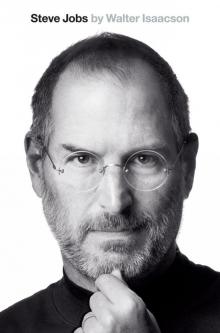 Steve Jobs
Steve Jobs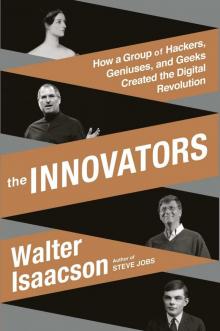 The Innovators
The Innovators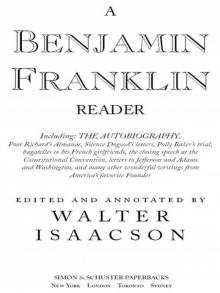 A Benjamin Franklin Reader
A Benjamin Franklin Reader